For Southwest borders in harsh conditions, you’ll find remarkable survivors in native agaves, yuccas, and prickly pear cacti. Texas sage, lantana, and autumn sage add color while requiring minimal water. Consider ocotillo fencing for traditional living barriers, or incorporate drought-resistant grasses like blue grama and buffalograss. All these plants offer security through natural barriers while attracting beneficial pollinators. These tough desert beauties will transform your property line into a thriving ecosystem despite punishing heat and limited rainfall.
Native Agave Species as Living Boundary Markers
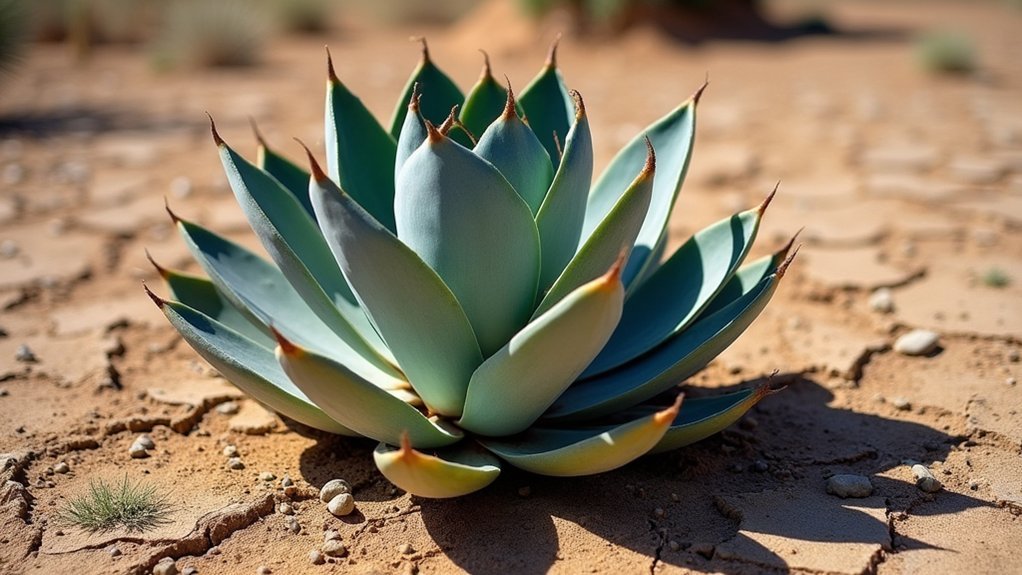
While many homeowners struggle with boundary solutions in arid climates, native agave species offer a beautiful and practical alternative to traditional fencing. The Whale’s Tongue Agave (Agave ovatifolia) stands out with its striking blue-gray foliage that clearly marks property lines while thriving in harsh conditions.
Native agaves transform property boundaries with resilient beauty where traditional options fail in challenging desert environments.
These drought-tolerant plants require minimal water once established, making them perfect for Southwestern landscapes where resources are scarce. You’ll appreciate their resilience in extreme heat and poor soil, as they continue to flourish where other plants fail.
Beyond their boundary-marking capabilities, agaves provide multiple benefits: their impressive flower spikes attract essential pollinators, while their robust root systems aid in soil stabilization and erosion control.
Their hardiness in zones as low as USDA 6 guarantees they’ll serve as living borders for years to come.
Drought-Hardy Yucca Varieties for Natural Perimeters
Creating effective boundaries in arid regions demands plants that combine toughness with visual impact, and drought-hardy yucca varieties deliver on both counts.
You’ll find these drought-resistant plants thrive in harsh environments while providing natural security through their dense foliage and sharp leaf tips.
- Red Yucca (Hesperaloe parviflora) features arching grass-like leaves and bright red tubular flowers that attract hummingbirds while requiring minimal water.
- Spanish Dagger Yucca (Yucca gloriosa) stands out with dramatic sword-like leaves and creamy white flower clusters, tolerating poor soil and extreme heat.
- Adam’s Needle Yucca (Yucca filamentosa) offers versatility across USDA zones 4-10, making it adaptable throughout the Southwest while maintaining its protective barrier qualities.
Once established, these yuccas create formidable yet attractive natural perimeters with almost no maintenance required.
Prickly Pear Cactus: The Ultimate Southwest Barrier Plant

Prickly Pear cacti stand as the Southwest’s quintessential barrier plant, combining imposing defense with striking beauty. You’ll find this drought-tolerant plant thriving in even the harshest conditions, requiring minimal water and flourishing in poor soil.
Native to the Southwest, these resilient cacti can reach impressive heights of 10 feet, creating formidable natural barriers around your property. Their flat pads, covered in protective spines, effectively deter both wildlife and unwanted human visitors.
A natural security system for your landscape, towering up to 10 feet with spine-covered pads that keep intruders at bay.
Don’t let their defensive nature fool you—Prickly Pears offer stunning vibrant flowers in spring, showcasing yellow, red, or purple blooms that attract beneficial pollinators.
As an added bonus, you’ll enjoy their edible fruits called “tunas,” which are packed with vitamins and can be harvested for jams, jellies, and southwestern cuisine.
Texas Sage and Silverleaf for Attractive Property Lines
You’ll find Texas Sage and Silverleaf to be exceptional drought-resilient options for defining your property boundaries in harsh southwestern conditions.
Their silvery foliage creates a stunning visual anchor that reflects sunlight and reduces water loss during intense summer heat.
These native plants work together to form an attractive, low-maintenance border that thrives with minimal irrigation while providing year-round structure and seasonal purple blooms.
Drought-Resilient Border Options
When faced with the harsh conditions of the Southwest, homeowners can turn to Texas Sage and Silverleaf for stunning property borders that thrive despite minimal rainfall.
These drought-tolerant plants offer beauty without demanding constant attention, making them perfect for low-maintenance landscaping.
- Texas Sage’s silvery foliage and vibrant purple blooms create visual interest while attracting essential pollinators to your garden.
- Silverleaf’s striking silver-blue leaves and attractive flowers flourish in poor soils with minimal water once established.
- Both options provide vital habitat for local wildlife, enhancing biodiversity across Southwest properties.
Silvery Foliage Benefits
The silvery leaves of Texas Sage and Silverleaf do far more than simply catch the eye along property borders. This distinctive foliage reflects intense sunlight, reducing heat absorption and conserving precious moisture in your landscape.
You’ll appreciate how these drought-tolerant plants create striking visual contrast against darker greenery while defining property lines with elegance.
Both varieties thrive in well-drained soil and require minimal irrigation once established, making them ideal low-maintenance options for busy homeowners. Their adaptive characteristics allow them to endure extreme temperatures while still looking magnificent.
Beyond their water-wise benefits, these silvery-leaved plants attract pollinators like bees and butterflies, enhancing your garden’s biodiversity.
Desert Willow: Combining Beauty With Boundary Function
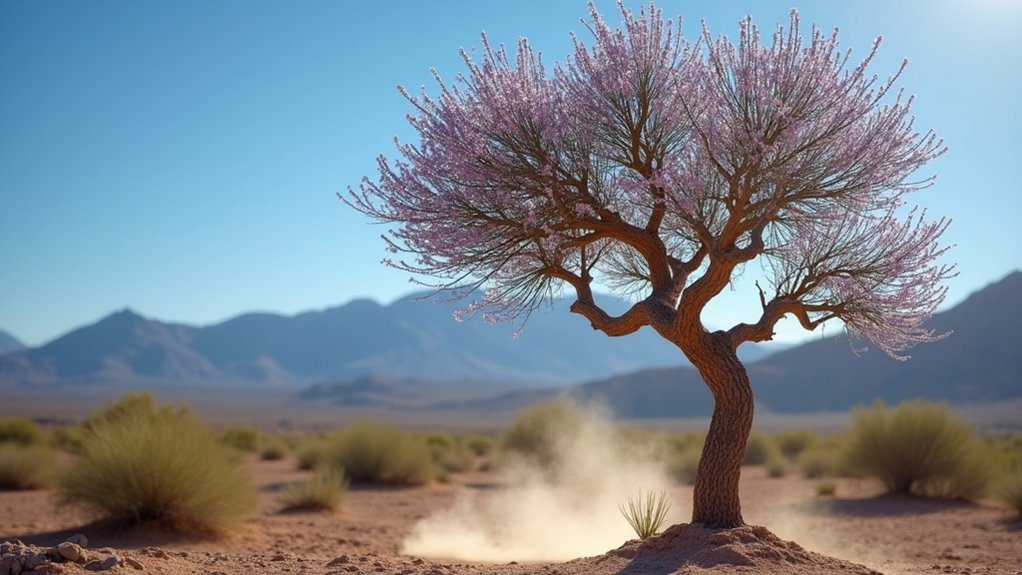
Looking to create a stunning natural border that thrives in harsh conditions?
The Desert Willow’s trumpet-shaped blooms in vibrant pinks, purples, and whites will transform your property line into a pollinator paradise while standing tall against summer heat.
You’ll enjoy this native showstopper’s ability to reach 30 feet in height while attracting a steady stream of hummingbirds and butterflies to your boundary plantings.
Native Showstopper
Majestic yet unassuming, Desert Willow stands as a true star among native Southwest landscape options.
You’ll appreciate this drought-tolerant beauty that thrives in full sun while requiring minimal maintenance after establishment. Growing up to 30 feet tall, this native showstopper creates effective boundaries while putting on a spectacular floral display that attracts essential pollinators to your garden.
- Trumpet-shaped blooms in pink, white, and lavender create vibrant color splashes against the desert backdrop
- Willow-like foliage provides a graceful, airy appearance that complements its striking flowers
- Exceptional hardiness allows it to flourish where other ornamentals fail, withstanding extreme heat and limited water
Plant Desert Willow where you can enjoy its seasonal transformation and watch as hummingbirds and butterflies make it their preferred destination.
Drought-Defying Bloomer
With three standout qualities, Desert Willow earns its reputation as a drought-defying bloomer that transforms southwestern landscapes.
First, this remarkable tree produces stunning trumpet-shaped flowers in pink, lavender, and white that attract pollinators like hummingbirds and bees throughout the growing season.
Second, you’ll appreciate how Desert Willow thrives in harsh conditions where other plants struggle. Its deep roots efficiently capture scarce moisture, allowing it to flourish even during intense summer heat with minimal irrigation.
Finally, this drought-tolerant plant offers practical benefits beyond its beautiful blooms. Growing 15-25 feet tall with a 10-15 foot spread, you can use Desert Willow as an attractive boundary or privacy screen.
Its adaptability to poor, sandy soils makes it perfect for xeriscaping in USDA zones 7-11.
Wildlife Attraction Powerhouse
Homeowners seeking both beauty and functionality often discover that Desert Willow serves as a wildlife attraction powerhouse while defining property boundaries.
This drought-tolerant native plant transforms your landscape into a bustling ecosystem while requiring minimal care.
The trumpet-shaped blooms in pink, white, and purple aren’t just visually striking—they’re irresistible to local fauna.
You’ll enjoy:
- A constant parade of hummingbirds hovering around the vibrant flowers throughout the blooming season
- Butterflies that flock to this low-maintenance tree, adding movement and life to your xeriscaping efforts
- Increased biodiversity that creates a healthier garden ecosystem while maintaining an attractive border
Native Grasses That Define Southwest Garden Edges
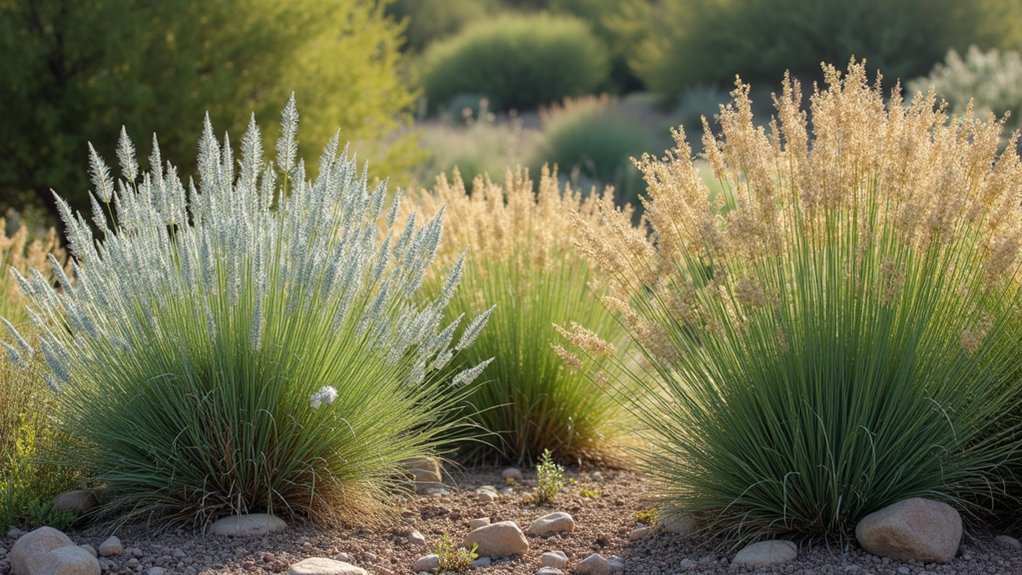
Resilient survivors of the desert’s extreme conditions, native grasses offer Southwest gardeners a perfect solution for defining garden boundaries with minimal maintenance. These drought-tolerant champions thrive where other plants fail, establishing deep root systems that improve soil health and prevent erosion along your garden’s edges.
| Grass Variety | Benefits | Adaptability |
|---|---|---|
| Blue Grama | Minimal water needs | Thrives in poor soils |
| Buffalograss | Extreme heat tolerance | Perfect for low-traffic areas |
| Sideoats Grama | Distinctive seed heads | Adapts to various soil types |
You’ll boost biodiversity by incorporating grasses like Indian Ricegrass, which provides essential habitat and food for wildlife. These low-maintenance border options don’t just survive—they help your entire garden ecosystem thrive while creating visually appealing, sustainable boundaries.
Ocotillo Fencing: Traditional Boundary Solutions
You’ll find few boundary options more deeply rooted in Southwest tradition than the striking ocotillo fence, which transforms desert-adapted stems into living barriers that blend security with natural beauty.
Creating these living fences involves planting dried ocotillo canes that remarkably reroot and leaf out, continuing a boundary practice that dates back centuries among indigenous peoples and Spanish settlers.
When you install an ocotillo fence, you’re not just establishing a property line—you’re participating in a desert tradition that honors regional identity while providing a functional, flowering border that thrives in arid conditions.
Living Fence Creation
While conventional fencing materials like wood and metal dominate modern landscapes, the ocotillo plant offers a living alternative deeply rooted in Southwestern tradition.
You’ll find this drought-tolerant specimen thrives in harsh conditions where other plants struggle, reaching heights up to 20 feet to create an effective natural barrier.
To establish your ocotillo living fence:
- Plant stems 18-24 inches deep in sandy soil, spacing them 3-4 feet apart for an impenetrable boundary
- Water sparingly after establishment—once every 3-4 weeks during extreme drought
- Expect vibrant red tubular flowers in spring that will attract hummingbirds and pollinators
With minimal maintenance, your ocotillo fence will define your property lines while adding authentic Southwestern character that commercially manufactured fencing simply can’t match.
Historic Boundary Solution
Before modern fencing materials arrived in the Southwest, indigenous peoples and early settlers relied on ocotillo (Fouquieria splendens) as an ingenious boundary solution that required minimal resources. This native plant served both practical and sustainable purposes, with its tall, spiny stems creating effective boundary fencing that clearly defined property lines.
You’ll appreciate ocotillo’s remarkable drought-tolerant nature, which allows it to thrive in arid environments with infrequent watering once established. The plant’s distinctive structure, featuring rosette-formed narrow leaves that minimize water loss, makes it perfectly adapted to harsh desert conditions.
Beyond functionality, ocotillo fencing represents a sustainable solution that harmonizes with the local ecosystem. Its vibrant red tubular spring flowers add aesthetic value while maintaining cultural traditions that honored the delicate balance of Southwest landscapes.
Rooted Desert Tradition
Generations of Southwestern residents have embraced ocotillo fencing as more than just a practical boundary solution—it’s a living symbol of regional ingenuity.
This drought-tolerant flowering shrub thrives where other plants fail, reaching impressive heights of up to 20 feet while requiring minimal care in harsh desert conditions.
When you plant ocotillo as a natural fence, you’re continuing a cultural heritage practice that connects you to the Southwest’s sustainable landscaping traditions.
During spring, you’ll enjoy the added benefit of vibrant red tubular flowers that attract hummingbirds to your property.
- Adapts to poor soil and extreme temperatures, making it ideal for challenging Southwest environments
- Requires infrequent watering, perfect for water-conscious gardeners
- Creates both functional boundaries and striking visual elements in your desert landscape
Drought-Resistant Shrubs for Continuous Border Definition
Creating a well-defined border that withstands harsh Southwest conditions doesn’t require sacrificing beauty for practicality.
You’ll find drought-tolerant plants like Texas Sage deliver year-round interest with its distinctive silvery foliage and vibrant purple blooms requiring minimal water once established.
Incorporate Lantana for continuous color in full sun areas where other plants struggle.
For versatility, consider Autumn Sage, an evergreen shrub that attracts pollinators while adapting perfectly to local climate variations.
Red Yucca makes a striking statement with its red flowers that draw hummingbirds, while requiring virtually no maintenance.
For lower-height definition, Dwarf Yaupon Holly offers compact structure and surprising fall berries.
These hardy selections create borders that remain defined and attractive throughout seasons while conserving water and reducing your maintenance time.
Southwestern Succulents That Thrive in Harsh Border Conditions
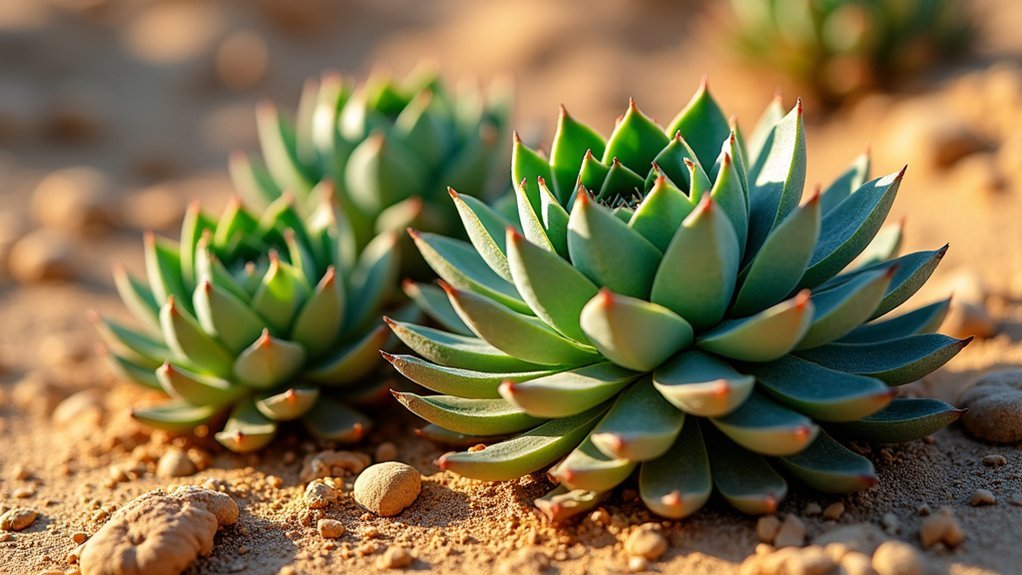
While many plants struggle in the unforgiving Southwest climate, native succulents offer exceptional border solutions that embrace these harsh conditions.
These drought-tolerant specimens not only survive but thrive where other plants fail, creating striking visual interest along property boundaries.
When selecting succulents for your Southwest border plantings, consider:
- Whale’s Tongue Agave with its impressive blue-gray foliage that requires minimal water once established
- Ocotillo’s dramatic spiny stems that erupt with vibrant red tubular flowers in spring, attracting hummingbirds
- Pink Fairy Duster’s delicate appearance belying its toughness, offering fuzzy pink blossoms amid airy foliage
Other excellent choices include Candelilla with its gray-green stems and Common Sotol’s architectural rosette form—both perfect for harsh, arid conditions where water conservation is essential.
Heat-Tolerant Flowering Perennials for Colorful Property Boundaries
Beyond the sculptural appeal of succulents, heat-tolerant flowering perennials offer vibrant color solutions for Southwest property boundaries.
Blackfoot Daisy delivers inch-wide blooms above dark green foliage with minimal summer watering, while Angelita Daisy’s bright yellow flowers thrive with weekly irrigation in well-drained soil.
For eye-catching property boundaries that attract pollinators, consider Globe Mallow’s colorful cup-shaped blooms, which need water only every two to three weeks.
Firecracker Penstemon draws hummingbirds with its dramatic 2-foot flower spikes, requiring weekly watering only during bloom time.
Southwestern Mock Vervain creates stunning purple clusters along drought-tolerant borders.
Its pollinator-friendly flowers make it perfect for defining colorful property lines in harsh climates where other plants struggle to survive.
Frequently Asked Questions
What Plant Survives the Harshest Conditions?
You’ll find Ocotillo (Fouquieria splendens) survives the harshest conditions with its ability to thrive in extreme desert environments, tolerate prolonged drought, and quickly produce leaves after minimal rainfall.
What Are the Best Low Maintenance Border Plants?
For low-maintenance border plants, you’ll love lantana, autumn sage, black-eyed Susan, Texas sage, and red yucca. They’re drought-resistant, require minimal care, and reward you with vibrant colors while attracting beneficial pollinators.
What Plants Can Survive in Extreme Heat and Cold?
You’ll find Whale’s Tongue Agave, Common Sotol, and Pink Fairy Duster thrive in both extreme heat and cold. They’re drought-tolerant, require minimal maintenance, and can withstand harsh temperature fluctuations in USDA Zone 7.
What Is the Plant Life in the Southwest Region?
You’ll find diverse, drought-adapted vegetation in the Southwest region, including cacti, succulents, agaves, ocotillos, and colorful flowering plants like globe mallow and firecracker penstemon that thrive in sandy, rocky soil.
In Summary
Southwest border plants aren’t just survivors—they’re thrivers! You’ll find agave, yucca, prickly pear, and ocotillo create natural, durable boundaries while Texas sage and desert willow add beauty to your property lines. When you’re planning your landscape, don’t overlook these native champions that have evolved to withstand intense sun, minimal water, and temperature extremes. They’ll define your space beautifully while demanding little maintenance in return.

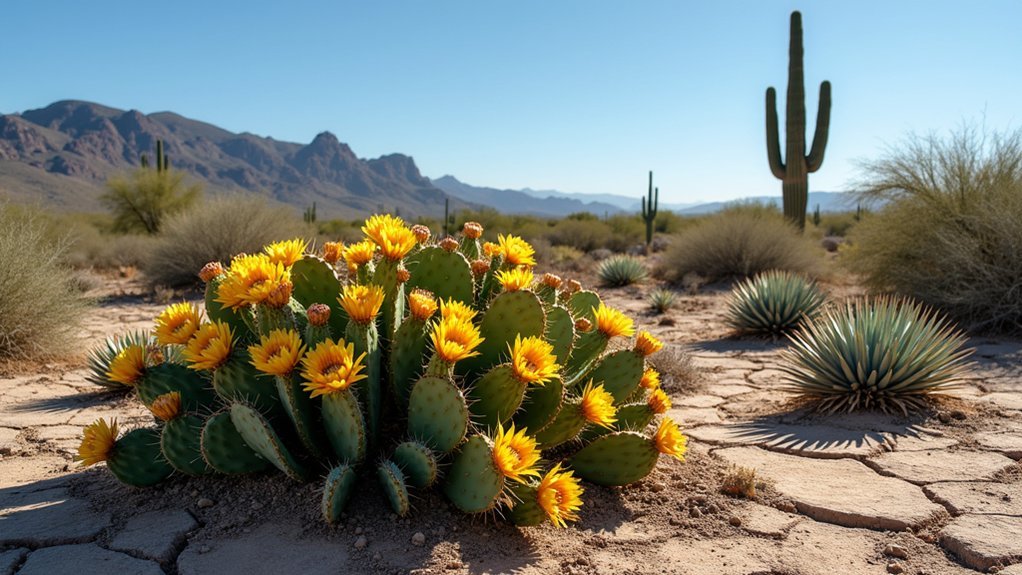

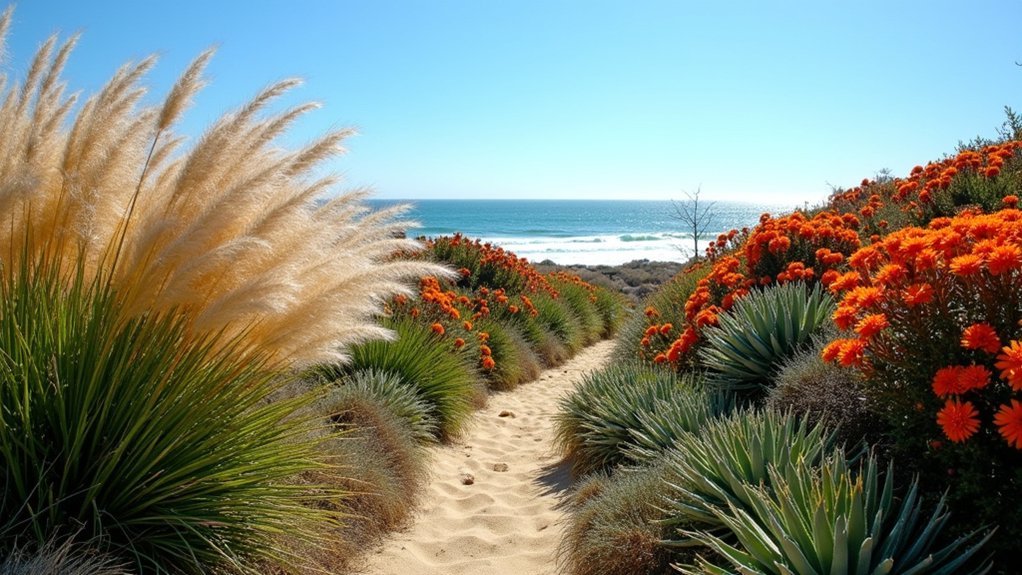
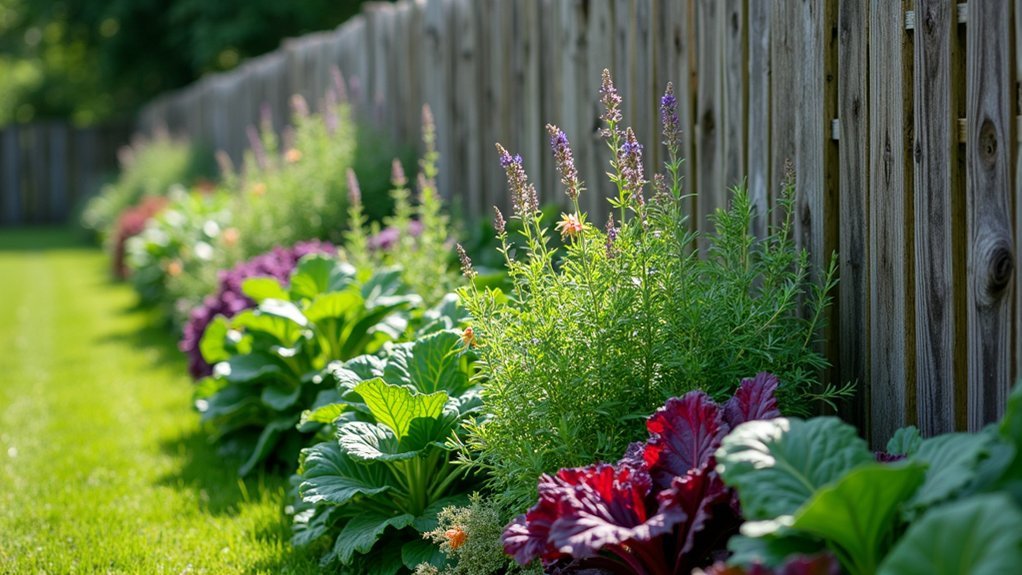
Leave a Reply